Connecting your iPhone to your car’s OBD2 port can unlock a wealth of information about your vehicle’s performance and health. While it might seem straightforward, getting your iPhone to work with an OBD2 scanner, specifically the common ELM327 Bluetooth adapter, can be tricky. This guide will walk you through the process and address common compatibility issues.
Understanding the Challenge: iPhone and ELM327 Compatibility
The ELM327 is a popular Bluetooth OBD2 adapter that allows you to access your car’s data using a smartphone or tablet. However, iPhones and iPads often struggle to pair directly with ELM327 devices due to compatibility issues with the Bluetooth protocols used. While Android devices readily recognize and pair with these adapters, iOS devices often fail to detect the ELM327 during the Bluetooth pairing process. This incompatibility stems from the specific Bluetooth stack implementation in iOS.
Solutions for Connecting Your iPhone to OBD2
Despite the direct compatibility challenges, there are several ways to successfully connect your iPhone to your car’s OBD2 port:
1. Using WiFi OBD2 Adapters:
Opting for a WiFi-enabled OBD2 adapter is often the most reliable solution for iPhone users. These adapters create their own wireless network, allowing your iPhone to connect without relying on the standard Bluetooth pairing process. Simply connect your iPhone to the WiFi network broadcasted by the adapter and use a compatible app to access your car’s data.
2. Selecting Compatible ELM327 Adapters:
While less common, some ELM327 adapters are specifically designed to work with iOS devices. These adapters often utilize a modified Bluetooth chipset or firmware that addresses the compatibility issues encountered with standard ELM327 devices. Research and choose adapters explicitly stating iOS compatibility.
3. Leveraging Third-Party Apps:
Several apps available on the App Store facilitate the connection between your iPhone and an OBD2 adapter. These apps often incorporate specific workarounds for compatibility issues and provide a user-friendly interface for accessing and interpreting vehicle data.
Troubleshooting Connection Problems
If you encounter difficulties connecting your iPhone to your OBD2 adapter, consider these troubleshooting steps:
- Verify Adapter Compatibility: Ensure your chosen adapter explicitly states compatibility with iOS devices.
- Update Firmware: Check for firmware updates for your OBD2 adapter, as these updates may address compatibility issues.
- Restart Devices: Restart both your iPhone and the OBD2 adapter to resolve temporary connection glitches.
- Check App Settings: Ensure the app you are using is correctly configured to connect to your chosen adapter.
Conclusion
Connecting your iPhone to your car’s OBD2 port using an ELM327 or other adapter can provide valuable insights into your vehicle’s performance. By understanding the compatibility challenges and utilizing the solutions outlined in this guide, you can successfully access and interpret your car’s data using your iPhone. Remember to choose compatible hardware and software, and troubleshoot any connection issues systematically.
